Camshaft -- Installation |
| 1. INSTALL CAMSHAFT TIMING GEAR |
Put the camshaft timing gear and camshaft together by aligning the key groove and straight pin.
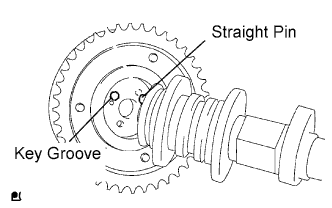 |
Check that there is no gap between the gear's flange and the camshaft.
With the camshaft timing gear fixed in place, install the flange bolt.
- Torque:
- 78 N*m{795 kgf*cm, 58 ft.*lbf}
| 2. INSTALL VALVE STEM CAP |
Apply clean engine oil to the valve stem tip, and install each valve stem cap.
- NOTICE:
- Install each cap to the same place it was removed from.
| 3. INSTALL VALVE LASH ADJUSTER |
- NOTICE:
- Keep the lash adjuster free from dirt and foreign objects.
- Only use clean engine oil.
Place the lash adjuster into a container full of engine oil.
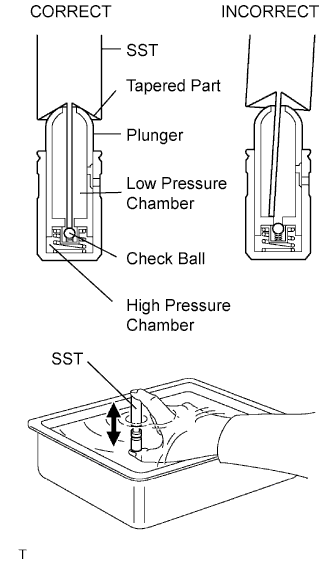 |
Insert SST's tip into the lash adjuster's plunger and use the tip to press down on the check ball inside the plunger.
- SST
- 09276-75010
Squeeze SST and lash adjuster together to move the plunger up and down 5 to 6 times.
Check the movement of the plunger and bleed air.
- OK:
- Plunger moves up and down.
- NOTICE:
- When bleeding high-pressure air from the compression chamber, make sure that the tip of SST is actually pressing the check ball as shown in the illustration. If the check ball is not pressed, air will not bleed.
After bleeding air, remove SST. Then, try to quickly and firmly press the plunger with a finger.
- OK:
- Plunger is very difficult to move.
Install the lash adjuster.
- HINT:
- Repeat the same procedures and install the remaining lash adjusters.
- NOTICE:
- Install each lash adjuster to the same place it was removed from.
| 4. INSTALL VALVE ROCKER ARM |
Apply clean engine oil to the valve lash adjuster tips and valve stem cap surfaces. Then install the valve rocker arms.
- NOTICE:
- Install each valve stem cap and valve rocker arm to the same place it was removed from.
| 5. INSTALL CAMSHAFT |
Apply clean engine oil to the camshaft's cam portion and the cylinder head journals.
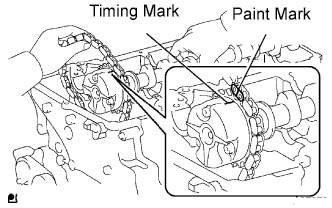 |
Install the timing chain on the camshaft timing gear with the painted mark of the link aligned with the timing mark of the camshaft timing gear.
Set the 2 camshafts as shown in the illustration.
- NOTICE:
- Align the paint mark and timing mark before setting the camshaft.
Before and after setting the camshaft and No. 2 camshaft, check that the rocker arm is firmly set to the lash adjuster.
 |
Loosely install the No. 1 camshaft bearing cap.
 |
Confirm the proper location of each camshaft bearing cap and install each one.
Install a new O-ring to the No. 1 camshaft bearing cap.
 |
Temporarily install the oil delivery pipe.
Temporarily install the 21 bolts and 20 washers. Tighten the 21 bolts and 20 washers in the order shown in the illustration.
- Torque:
- 12 N*m{122 kgf*cm, 9 ft.*lbf}for bolt A
- 15.5 N*m{158 kgf*cm, 11 ft.*lbf}for except bolt A
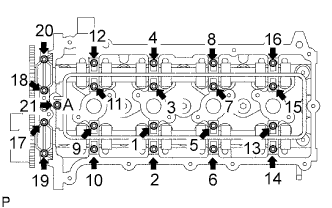 |
| 6. INSTALL CAMSHAFT TIMING SPROCKET |
Rotate the camshaft so that the camshaft's timing mark and the No. 2 camshaft knock pin are as shown in the illustration.
 |
Turn the crankshaft pulley, and align its groove with timing mark 0 of the timing chain cover.
Install the timing chain on the camshaft timing sprocket with the paint mark aligned with the timing marks on the camshaft timing sprocket.
 |
Align the No. 2 camshaft knock pin and camshaft timing sprocket's pin hole. Then install the camshaft timing sprocket to the No. 2 camshaft.
- NOTICE:
- If the knock pin and pin hole are difficult to align, slightly rotate the No. 2 camshaft to the left and right using the camshaft's hexagon-shaped part. Then attempt alignment again.
Fix the camshaft in place with a wrench, and then tighten the sprocket bolt.
- Torque:
- 78 N*m{795 kgf*cm, 58 ft.*lbf}
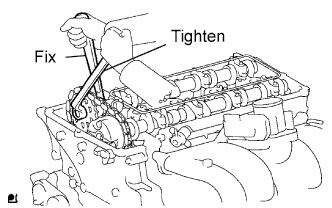 |
Remove the hexagon wrench from the chain tensioner.
Apply adhesive to 2 or 3 threads of the timing chain cover plug.
- Adhesive:
- Toyota Genuine Adhesive 1324, Three Bond 1324 or equivalent
- NOTICE:
- Remove any oil from the bolt hole.
 |
Using a 10 mm socket hexagon wrench, install the timing chain cover plug.
- Torque:
- 16.6 N*m{169 kgf*cm, 12 ft.*lbf}
| 7. INSTALL TIMING CHAIN GUIDE |
Install a new O-ring to the camshaft bearing cap.
 |
Install the timing chain guide with the 2 bolts.
- Torque:
- 10 N*m{102 kgf*cm, 7 ft.*lbf}
| 8. INSTALL CYLINDER HEAD COVER |
Install the 2 gaskets to the cylinder head cover.
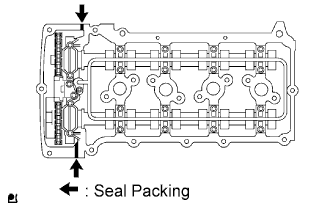 |
Remove any old packing (FIPG) material.
Apply seal packing to the 2 locations shown in the illustration.
- Seal packing:
- Toyota Genuine Seal Packing Black, Three Bond 1207B or equivalent
- NOTICE:
- Remove any oil from the contact surfaces.
- Install the cylinder head cover within 3 minutes after applying seal packing.
- Do not apply engine oil for at least 2 hours after the installation.
Loosely install the head cover with the 19 bolts and 2 nuts.
 |
Uniformly tighten the 19 bolts and 2 nuts in the sequence shown in the illustration.
- Torque:
- 9.0 N*m{92 kgf*cm, 80 in.*lbf}
In numerical order, confirm that the bolts labeled 1 to 18 are tightened to the torque specification. Tighten the bolts as necessary.
Connect the wire harness to the 6 clamps.
| 9. INSTALL IGNITION COIL |
Install the ignition coil with the bolt.
- Torque:
- 9.0 N*m{92 kgf*cm, 80 in.*lbf}
| 10. INSTALL INTAKE AIR CONNECTOR |
Install the air cleaner and intake air connector assembly with the 4 bolts, and tighten the hose clamp.
- Torque:
- 14 N*m{143 kgf*cm, 10 ft.*lbf}for air cleaner
- 8.0 N*m{82 kgf*cm, 71 in.*lbf}for intake air connector
- 5.0 N*m{51 kgf*cm, 44 in.*lbf}for hose clamp
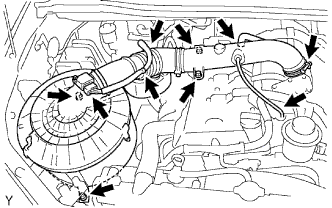 |
Connect the MAF meter connector and harness clamps.
Connect the No. 2 ventilation hose.
Connect the vacuum hose.
| 11. INSTALL DRIVE BELT |
Install the drive belt to all the pulleys except the drive belt tensioner pulley.
 |
Use the hexagon-shaped part indicated by the arrow in the illustration to move the tensioner pulley downward and then install the drive belt to the tensioner pulley.
- NOTICE:
- The backside of the drive belt should face the tensioner pulley.
- Check that the drive belt is properly set to each pulley.
After a new belt has been installed, check that the tensioner indicator mark is within range A shown in the illustration.
 |
| 12. CONNECT CABLE TO NEGATIVE BATTERY TERMINAL |
| 13. INSPECT FOR ENGINE OIL LEAK |
Start the engine, and check that there are no oil leaks after performing maintenance.
| 14. INSPECT FOR ENGINE COOLANT LEAK |
- CAUTION:
- Do not remove the radiator cap while the engine and radiator are still hot. Pressurized, hot engine coolant and steam may be released and cause serious burns.
Fill the radiator with coolant and attach a radiator cap tester.
 |
Warm up the engine.
Using the radiator cap tester, increase the pressure inside the radiator to 118 kPa (1.2 kgf/cm2, 17.1 psi), and check that the pressure does not drop.
If the pressure drops, check the hoses, radiator and water pump for leaks. If no external leaks are found, check the cylinder block and head.
| 15. CHECK IGNITION TIMING |
Warm up the engine and stop the engine.
- NOTICE:
- A warmed up engine should have an engine coolant temperature of over 80°C (176°F), have an engine oil temperature of 60°C (140°F), and the engine rpm should be stabilized.
When using the intelligent tester:
Check the ignition timing.Connect the intelligent tester to the DLC3.
Start the engine and idle the engine.
Turn the intelligent tester main switch ON.
Enter the following menus: Powertrain / Engine and ECT / Data List / IGN Advance.
- Standard ignition timing:
- 0 to 20° BTDC @ idle
- HINT:
- Please refer to the intelligent tester operator's manual for further details.
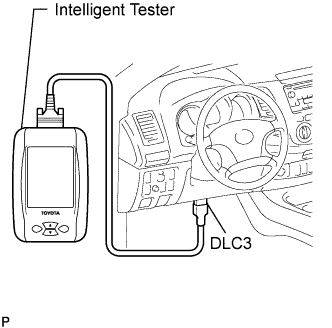 |
When not using the intelligent tester:
Check the ignition timing.Using SST, connect a tachometer tester probe to terminal 9 (TAC) of the DLC3.
- SST
- 09843-18030
- NOTICE:
- Confirm the terminal number before connecting SST. Connection with a wrong terminal can damage the engine.
- Turn off all electrical systems before connecting SST.
Clamp a timing light tester probe to the No. 1 cylinder ignition coil connector's 4 lead wires or green-red lead wire.
Start the engine.
Using SST, connect terminals 13 (TC) and 4 (CG) of the DLC3.
- SST
- 09843-18040
- NOTICE:
- When checking the ignition timing, the transmission should be in the neutral position.
- HINT:

- After connecting terminals TC and CG, the engine rpm changes to approximately 1,000 to 1,500 rpm for 5 seconds, and then returns to idle speed. This occurs because the ECM checks that the ISC (idle speed control system) is operating properly.
- Perform the inspection of the ignition timing after the engine rpm has returned to idle speed.
Using a timing light, measure the ignition timing.
- Standard ignition timing:
- 3 to 7° BTDC @ idle
Remove SST from terminals 13 (TC) and 4 (CG) of the DLC3.
Check the ignition timing.
- Standard ignition timing:
- 0 to 20° BTDC @ idle
Confirm that the ignition timing moves to the advanced angle side when the engine speed is increased.
Remove the timing light.

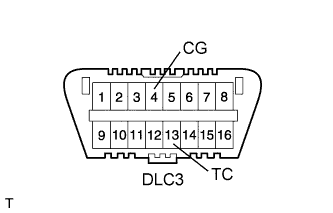

 |
| 16. CHECK IDLE SPEED |
Warm up and stop the engine.
- NOTICE:
- A warmed up engine should have an engine coolant temperature of over 80°C (176°F), have an engine oil temperature of 60°C (140°F), and the engine rpm should be stabilized.
When using the intelligent tester:
Check the idle speed.Connect the intelligent tester to the DLC3.
- HINT:
- Please refer to the intelligent tester operator's manual for further details.
Start the engine and idle the engine.
Turn the intelligent tester main switch ON.
Enter the following menus: Powertrain / Engine and ECT / Data List / Engine SPD.
- Standard idle speed:
- 600 to 700 rpm
- NOTICE:
- When checking the idle speed, the transmission should be in the neutral position.
- Switch off all accessories and the air conditioning before connecting the intelligent tester.

When not using the intelligent tester:
Check the idle speed.Using SST, connect a tachometer tester probe to terminal 9 (TAC) of the DLC3.
- SST
- 09843-18030
- NOTICE:
- Confirm the terminal number before connecting SST. Connection with a wrong terminal can damage the engine.
- Turn off all electrical systems before connecting SST.
Start the engine and idle the engine.
Check the idle speed.
- Standard idle speed:
- 600 to 700 rpm
 |
| 17. CHECK CO (for Leaded Gasoline Specification Vehicle) |
- HINT:
- This check is used only to determine whether or not the idle CO complies with regulations.
Initial condition:
Engine at normal operating temperature
Air cleaner installed
All pipes and hoses of air induction system connected
All accessories switched OFF
All vacuum lines properly connected
SFI system wiring connectors fully seated
Ignition timing set correctly
Transmission in neutral position
Tachometer and CO meter calibration at idle
- NOTICE:
- If a CO meter is not available, do not attempt to adjust the idle mixture. Always use a CO meter when adjusting the idle mixture. Use of the idle mixture screw for adjustments is typically not necessary if the vehicle is in good condition.
Warm up the engine at a constant speed (approximately 50 km/h (31 mph)). Close the throttle valve for 5 minutes after the engine coolant temperature becomes stable (80 to 90°C (176 to 194°F)) and idle the engine for 5 minutes.
Insert a tester probe at least 40 cm (1.3 ft.) into the tailpipe.
 |
Wait at least 1 minute before measuring to allow the concentration to stabilize. Complete the measuring within 3 minutes.
- Standard idle CO concentration:
- 0.5 to 2.5%
If the CO concentration does not conform to regulations, adjust it by turning the idle mixture adjusting screw in the variable resistor with SST.
- SST
- 09243-00020
 |
The idle mixture adjusting screw can be adjusted within a 180° angle range.
If the CO concentration is within the specification, this adjustment is complete.
If the CO concentration cannot be corrected by idle mixture adjustment, see the table below for other possible causes.CO Problems Causes High Rough idle
(black smoke from exhaust)- Clogged air filter
- Plugged ventilation valve
- Faulty SFI system
- Faulty fuel pressure regulator
- Clogged fuel pressure regulator
- Defective engine coolant temperature (ECT) sensor
- Faulty ECM
- Faulty injectors
- Faulty throttle position sensor
- Faulty MAF meter
- Clogged air filter
 |
| 18. CHECK CO/HC (for Unleaded Gasoline Specification Vehicle) |
Start and warm up the engine.
Run the engine at 2,500 rpm for approximately 180 seconds and idle the engine.
Insert a CO/HC meter testing probe at least 40 cm (1.3 ft.) into the tailpipe.
 |
Check the CO/HC concentration at idle.
- Idle CO concentration:
- 0 to 0.5%
- Idle HC concentration:
- Applicable local regulation
If the CO/HC concentration is not as specified, perform troubleshooting in the order given below.
Check the heated oxygen sensor operation (Toyota Fortuner RM000000ZQ9007X.html).
See the table below for possible causes, and then inspect and repair the applicable causes as necessary.
CO HC Problems Causes Normal High Rough idle - Faulty ignitions:
- Incorrect timing
- Plugs are contaminated, shorted or gaps are defective
- Incorrect valve clearance
- Leaks in intake and exhaust valves
- Leaks in cylinders
Low High Rough idle
(Fluctuating HC reading)- Vacuum leaks:
- Ventilation hoses
- Intake manifold
- Throttle body
- Brake booster line
- Lean mixture causing misfire
High High Rough idle
(Black smoke from exhaust)- Restricted air filter
- Plugged ventilation valve
- Faulty SFI system:
- Faulty pressure regulator
- Defective ECT sensor
- Defective Mass Air Flow (MAF) meter
- Faulty ECM
- Faulty injectors
- Faulty throttle position sensor
- Faulty ignitions:
| 19. CHECK FUNCTION OF THROTTLE BODY |
Check the throttle control motor operating sound.
Turn the ignition switch ON.
When pressing the accelerator pedal, check the operating sound of the running motor. Make sure that no friction noises emit from the motor.
If friction noise is heard, replace the throttle body.
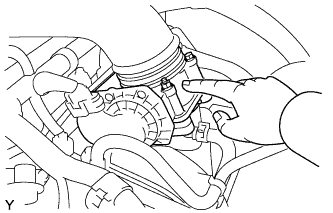 |
Check the throttle position sensor.
Connect the intelligent tester to the DLC3.
Turn the ignition switch ON.
Under Current Data, check that the throttle valve opening percentage (Throttle Pos) is within the standard.
- Standard throttle valve opening percentage:
- 60% or more
- NOTICE:
- When checking the standard throttle valve opening percentage, the shift lever should be in the N position.
 |